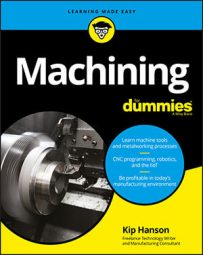It's no different on a machine tool, whose spindle contains various components including bearings, belts, and a motor contained within a metal housing, which is collectively known as a headstock. Though similar in function (they both spin), the headstocks used on lathes and mills have some substantial differences:
- A typical lathe headstock is a hollow tube surrounded by a set of bearings on each end and a series of belts somewhere in the middle. These pass around the spindle and down to the motor beneath, sort of like the fan belts in your car. On one end of the spindle you'll find a mounting arrangement, usually with a short locating taper and a series of bolt holes. Depending on the size of the lathe, this might be an A2-5 or A2-6 spindle nose, but some lathes have a flat cam-lock or threaded nose.
Whatever style your lathe has, its spindle nose provides a way in which to mount a chuck or collet mechanism. And because most spindles have a hollow tube inside, you can then pass a length of workpiece material — more commonly called "bar stock" — through the spindle and into the clamping mechanism. This is known as a "bar-fed" lathe, although there's nothing stopping you from also using the machine as a "chucker," meaning you can clamp a saw-cut blank in the chuck and easily turn it into a drink coaster or ashtray.
- Because the spindle on a mill or machining center grips a cutting tool rather than a workpiece, the hollow tube arrangement found in most lathes has been replaced with a "drawbar." As the name implies, these use a set of mechanical fingers or similar gripping mechanism to "draw" the toolholder into the spindle.
In most cases, the milling machine spindle bore has a precision-ground female taper that accurately positions the toolholder's matching male taper — picture an ice-cream cone (the toolholder) fitting into a child's hand (the spindle). For the past several decades, CAT and BT-style toolholders have dominated the CNC machining center market, but this is beginning to change in favor of competing — and far more rigid — styles of toolholder.
Bear with me on this one. Most lathes are "right-handed," which means that the chuck or other workholding device is located on the right side of the headstock (even though the headstock itself actually sits on the left side of the machine tool). If you're right-handed, you'll have no problem reaching in to load or measure a workpiece. On many Swiss-style and watchmaking lathes, however, the situation is the exact opposite — the workholding device (often called a guide bushing) is on the left side of the headstock, which is situated at the right side of the machine. Confused? Don't worry, it will all make perfect sense once you're actually standing in front of the machine.

